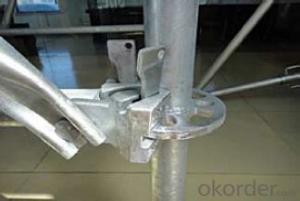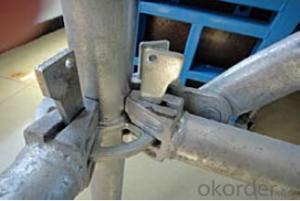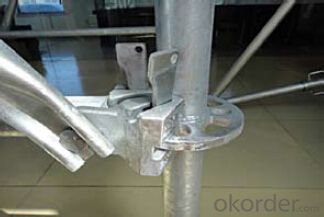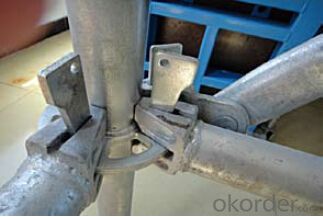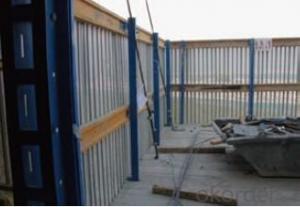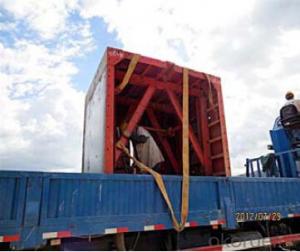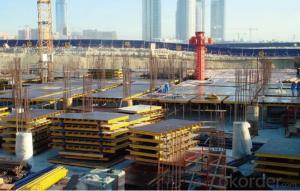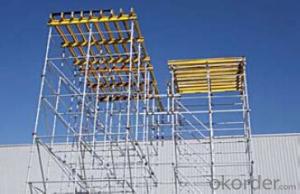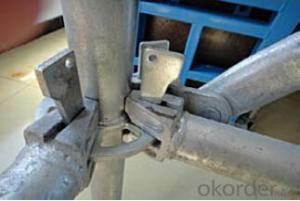Ring-Lock Scaffolding Accessories for scaffolding system
- Loading Port:
- Tianjin
- Payment Terms:
- TT OR LC
- Min Order Qty:
- 50 m²
- Supply Capability:
- 1000 m²/month
OKorder Service Pledge
Quality Product, Order Online Tracking, Timely Delivery
OKorder Financial Service
Credit Rating, Credit Services, Credit Purchasing
You Might Also Like
Ring-lock Scaffolding
A support system for construction, ownsadvantages of both cup-lock scaffolding andshoring tower.
It is in the development direction of new typescaffolding.
It is widely used in buildings, bridges, tunnels etc..
Characteristics:
◆ Easy to storage and transportation
◆ High degree of standardization
◆ Easy and quick erection
◆ Excellent stability and bearing capacity
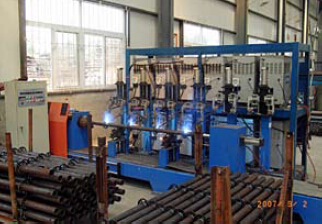
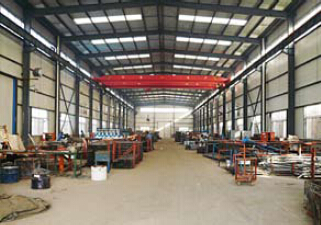
- Q: How does steel formwork contribute to the overall cost of concrete construction?
- Steel formwork can significantly contribute to the overall cost of concrete construction due to its initial higher cost compared to other formwork materials such as wood or plastic. However, it offers various advantages such as durability, reusability, and the ability to withstand higher loads, resulting in reduced labor and material costs in the long run. Moreover, steel formwork provides better quality finishes, faster construction time, and improved safety on-site, which can lead to overall cost savings and enhanced project efficiency.
- Q: Are there any specific maintenance requirements for steel formwork?
- Yes, there are specific maintenance requirements for steel formwork. Steel formwork is known for its durability and longevity, but regular maintenance is necessary to ensure its optimal performance and prolong its lifespan. One important maintenance requirement for steel formwork is cleaning. After each use, the formwork should be thoroughly cleaned to remove any concrete residue and prevent the buildup of corrosive agents. This can be done using water and a mild detergent, and ensuring that all surfaces are properly dried afterwards. Additionally, it is crucial to inspect the formwork for any signs of damage or wear. This includes checking for cracks, rust, or any other defects that may weaken the structure. Any damaged components should be repaired or replaced promptly to maintain the integrity and safety of the formwork. Furthermore, proper storage and handling are essential maintenance practices for steel formwork. The formwork should be stored in a dry and well-ventilated area to prevent corrosion. It should be protected from moisture, extreme temperatures, and direct sunlight. When handling the formwork, it is important to avoid any abrasive materials or tools that could cause scratches or dents. Regular lubrication of moving parts, such as hinges and locks, is also recommended to ensure smooth operation and prevent any seizing or jamming. Using a suitable lubricant will help reduce friction and extend the life of these components. Lastly, it is advisable to follow the manufacturer's guidelines and recommendations for specific maintenance requirements of the steel formwork. These guidelines may include additional steps or precautions that are specific to the particular formwork system being used. By adhering to these maintenance requirements, steel formwork can be kept in excellent condition, allowing for efficient and safe construction practices.
- Q: Can steel formwork be used in retail or commercial construction projects?
- Retail or commercial construction projects can benefit greatly from the use of steel formwork. This versatile and durable solution is ideal for creating concrete structures, offering numerous advantages. With its high reusability, excellent dimensional stability, and ability to handle high concrete pressures, steel formwork is a reliable choice. In these types of projects, steel formwork can be utilized for various applications including columns, walls, beams, slabs, and staircases. It provides a strong framework, ensuring accurate and smooth concrete placement, resulting in top-notch finishes. Moreover, steel formwork can be easily customized and adjusted to meet different project requirements, making it suitable for complex architectural designs. In addition to its flexibility, steel formwork also brings significant time and cost savings to construction projects. Its reusability minimizes the need for frequent formwork replacements, leading to reduced material and labor costs. The use of steel formwork further enhances construction efficiency by allowing for quick assembly, disassembly, and repositioning of formwork components. Overall, steel formwork is a dependable and efficient choice for retail or commercial construction projects, providing the necessary strength and flexibility for such applications.
- Q: What are the common safety guidelines when working with steel formwork in hazardous areas?
- To ensure the protection of workers and prevent accidents, certain safety guidelines must be adhered to when working with steel formwork in hazardous areas. Here are some commonly recommended safety guidelines: 1. Personal Protective Equipment (PPE): Workers must wear appropriate PPE, such as safety goggles, gloves, steel-toed boots, and hard hats, to safeguard themselves from potential hazards. 2. Training and Education: Adequate training on working with steel formwork and awareness of the specific hazards in the hazardous areas are essential. This includes understanding safe handling practices and emergency procedures. 3. Hazard Identification and Risk Assessment: Thoroughly assess the hazardous areas before starting work to identify potential risks and hazards. This will facilitate the implementation of suitable safety measures and controls. 4. Fall Protection: Proper fall protection measures should be in place when working at heights, including guardrails, safety harnesses, and safety nets. Workers should be trained on the correct use of fall protection equipment and systems. 5. Fire Safety: In hazardous areas, there is an increased risk of fire. Ensure the availability of fire extinguishers, train workers in their use, and have emergency evacuation plans in place. 6. Electrical Safety: Ensure proper grounding of electrical equipment or tools near the steel formwork and regularly inspect them for safety. Workers should exercise caution and avoid contact with live wires. 7. Proper Handling and Storage: Proper handling and storage of steel formwork materials are crucial to prevent injuries. This includes using appropriate lifting equipment, securely fastening the formwork, and storing it in designated areas to avoid tripping hazards. 8. Adequate Ventilation: If working in confined spaces, ensure proper ventilation to prevent the accumulation of toxic gases or fumes. Workers should be trained to recognize signs and symptoms of exposure to hazardous substances. 9. Regular Inspections and Maintenance: Regularly inspect the steel formwork and surrounding areas to identify any potential safety hazards. Promptly carry out any necessary repairs or maintenance. 10. Communication and Emergency Procedures: Establish clear communication between workers, supervisors, and other stakeholders to ensure awareness of potential hazards and emergency procedures. Regular safety meetings and drills can strengthen this communication. By adhering to these common safety guidelines, workers can minimize the risks associated with working with steel formwork in hazardous areas and create a safer working environment.
- Q: How does steel formwork compare to other formwork materials in terms of durability?
- Steel formwork is highly regarded for its exceptional durability when compared to other formwork materials. Steel is known for its strength and resilience, making it a reliable choice for construction projects that require long-lasting formwork. Unlike materials like wood or plastic, steel formwork is resistant to warping, cracking, and rotting, ensuring its longevity and effectiveness over time. Additionally, steel formwork is highly resistant to the elements, including harsh weather conditions and exposure to chemicals. It can withstand heavy loads and pressures, making it suitable for projects that involve high-rise buildings, bridges, or other structures that require robust support during the construction process. Furthermore, steel formwork offers the advantage of being reusable. After a concrete pour, steel formwork can be easily dismantled, cleaned, and reassembled for future use. This reusability factor not only reduces construction waste but also proves to be cost-effective in the long run. However, it is important to note that steel formwork requires regular maintenance to prevent corrosion. Proper cleaning, rust removal, and application of protective coatings are necessary to ensure the formwork's durability and extend its lifespan. In summary, steel formwork outperforms other formwork materials in terms of durability due to its strength, resistance to various elements, and reusability. While it requires maintenance to prevent corrosion, steel formwork remains a preferred choice for construction projects that demand long-lasting and reliable formwork solutions.
- Q: How does steel formwork contribute to the overall strength of the structure?
- Steel formwork contributes to the overall strength of a structure in multiple ways. Firstly, steel formwork provides a rigid framework that holds the concrete in place during the pouring and curing process. By ensuring that the concrete is properly contained and supported, steel formwork allows for the formation of a solid and uniform structure. Additionally, steel formwork helps in distributing the loads evenly across the structure. The steel panels and beams used in formwork are designed to withstand the pressure exerted by the wet concrete, ensuring that it is evenly distributed throughout the structure. This helps in preventing any weak spots or areas of uneven load distribution, ultimately enhancing the overall strength and stability of the structure. Furthermore, steel formwork provides reinforcement to the concrete. The steel panels and beams act as a reinforcement system, adding strength and durability to the structure. This reinforcement helps the structure withstand various external forces such as wind, earthquakes, and heavy loads, making it more robust and resistant to damage. Moreover, steel formwork allows for the creation of complex and intricate structures. Due to its high tensile strength and flexibility, steel can be easily shaped and molded into various forms, enabling the construction of unique and architecturally appealing designs. This versatility enhances the overall strength of the structure, as it can be tailored to withstand specific loads and forces. In summary, steel formwork contributes to the overall strength of a structure by providing a rigid framework, distributing loads evenly, reinforcing the concrete, and enabling the construction of complex designs. It plays a crucial role in ensuring that the structure is strong, durable, and capable of withstanding various external forces, making it a preferred choice in construction projects.
- Q: How does steel formwork contribute to the structural stability of the concrete elements?
- Steel formwork contributes to the structural stability of concrete elements by providing a rigid and durable framework during the pouring and curing process. It ensures that the concrete is poured in the desired shape and size, preventing any deformation or sagging. The steel formwork also supports the weight of the concrete and allows it to harden evenly, resulting in a stronger and more stable structure. Additionally, steel formwork helps in controlling the alignment and positioning of reinforcing bars, ensuring proper reinforcement for added strength and durability.
- Q: How does steel formwork affect the overall waste management of the construction process?
- Steel formwork can have a significant impact on the overall waste management of the construction process. Unlike traditional timber formwork, steel formwork is highly durable and reusable, which helps to minimize waste generation. This is because steel formwork can be used multiple times, reducing the need for frequent replacements and thereby reducing the amount of waste generated from discarded formwork materials. Moreover, steel formwork is typically fabricated off-site and can be easily disassembled and transported to different construction sites. This not only saves time and labor but also reduces the amount of waste generated during the construction process. In addition to its reusability, steel formwork is also recyclable. At the end of its life cycle, steel formwork can be melted down and reused to produce new steel products. This allows for a closed-loop recycling system, reducing the need for raw material extraction and minimizing the environmental impact associated with steel production. Another aspect to consider is the reduced maintenance required for steel formwork compared to other types of formwork. Since steel is highly resistant to wear and tear, it requires minimal repairs or replacements. This further reduces the waste generated during the construction process. Furthermore, steel formwork offers better dimensional accuracy and stability compared to other formwork materials. This results in reduced material wastage as the formwork provides precise shape and alignment, minimizing the need for excessive concrete pouring or trimming. Overall, the use of steel formwork positively impacts waste management in the construction process by minimizing waste generation, promoting reusability, facilitating recycling, reducing maintenance needs, and enhancing construction accuracy.
- Q: What are the considerations when designing steel formwork for underground utilities?
- When designing steel formwork for underground utilities, there are several important considerations to keep in mind. Firstly, the formwork must be able to withstand the pressure and weight of the surrounding soil and any potential water infiltration. It is crucial to ensure that the formwork is strong and stable enough to prevent any collapse or deformation during and after the pouring of concrete. Secondly, the formwork design should allow for easy installation and removal. Accessibility and maneuverability are key factors, as underground utilities can often be located in tight spaces or areas with limited access. The formwork should be designed in such a way that it can be easily assembled and disassembled without causing damage to the surrounding infrastructure. Additionally, the formwork needs to be corrosion-resistant to withstand the potentially corrosive environment of underground utilities. Steel formwork should be properly coated or treated to prevent rust and deterioration over time. Lastly, consideration should be given to the formwork's compatibility with other construction materials and techniques. The design should integrate well with other components of the underground utility system and accommodate any necessary connections or interfaces. Overall, the design of steel formwork for underground utilities requires careful attention to strength, stability, accessibility, corrosion resistance, and compatibility with other construction elements.
- Q: Can steel formwork be used for sports complex construction projects?
- Yes, steel formwork can be used for sports complex construction projects. Steel formwork is a versatile and durable option for creating temporary molds or structures for casting concrete. Its strength and flexibility make it suitable for various construction projects, including sports complexes. Steel formwork can provide the necessary support and stability required during the construction process, ensuring the efficient and accurate placement of concrete in complex shapes and designs.
Send your message to us
Ring-Lock Scaffolding Accessories for scaffolding system
- Loading Port:
- Tianjin
- Payment Terms:
- TT OR LC
- Min Order Qty:
- 50 m²
- Supply Capability:
- 1000 m²/month
OKorder Service Pledge
Quality Product, Order Online Tracking, Timely Delivery
OKorder Financial Service
Credit Rating, Credit Services, Credit Purchasing
Similar products
Hot products
Hot Searches
Related keywords
